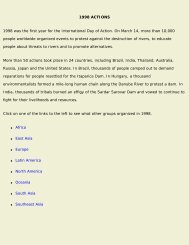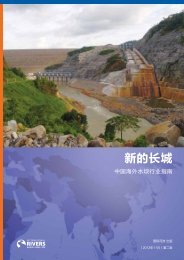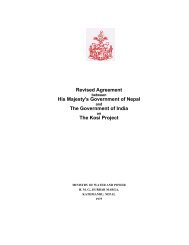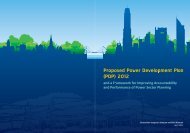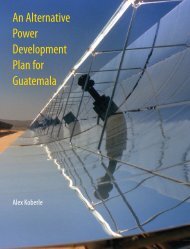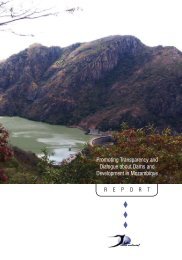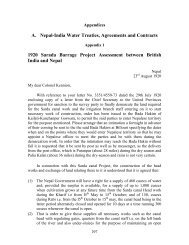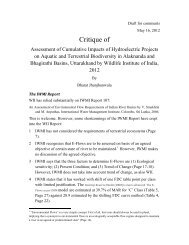Mountains of Concrete - International Rivers
Mountains of Concrete - International Rivers
Mountains of Concrete - International Rivers
You also want an ePaper? Increase the reach of your titles
YUMPU automatically turns print PDFs into web optimized ePapers that Google loves.
Funding RequirementsThe funds required by these projects are huge, and acquiring this financing is going to be a big challenge. Pakistan’sWater and Power Development Authority (WAPDA) estimates that it will need about $20.3 billion for the fiveprojects that it wants to build by 2016.The Diamer-Bhasha Dam alone is expectedto cost $8.5 billion, around 72% <strong>of</strong> thePakistani government’s annual revenue. 45 The14 projects planned for the next phase areexpected to cost $32.15 billion.There does not seem to be anyconsolidated estimate for all the dams plannedin Nepal, but we can use the costs <strong>of</strong> some<strong>of</strong> the key projects already underway or inan advanced stage <strong>of</strong> planning as a broadindicator. These 11 projects – Arun III, UpperTamakoshi, Upper Karnali, West Seti, MiddleMarsyangdi, Chameliya, Kulekhani-III, UpperTrishuli-3A, Rahughat, Upper Seti and UpperTrishuli-3B – are likely to cost about $3.8billion for a total <strong>of</strong> 2,134 MW <strong>of</strong> capacity.The actual costs are likely to be even higheras some <strong>of</strong> the estimates are quite old; formany projects the estimates were from theearly and mid-1990s. Already, the cost <strong>of</strong> theWest Seti project has been revised from $1.2billion to $1.6 billion. The annual revenue <strong>of</strong>the government <strong>of</strong> Nepal is about $1.2 billion.With Arun III estimated to cost $859 million(1995 estimate) and Upper Karnali $454million (1998 estimate), many <strong>of</strong> these damswill each cost anywhere between half to more than the totalannual revenue <strong>of</strong> Nepal.While there are no cost estimates available for many<strong>of</strong> the projects in Bhutan, with a rule <strong>of</strong> thumb <strong>of</strong> aboutIndian Rs. 5 crores per MW ($1.2 million per MW), 46 wecan estimate that Bhutan will need $12 billion in the nextTable 4: Funds Required For Himalayan Dams in the Next Ten YearsCountryCapacity Considered(MW)Construction <strong>of</strong> Teesta V Dam, Sikkim, India, 2008. India, with a huge plannedcapacity expansion <strong>of</strong> 50,000 MW in the next 10 years, will require funds to thetune <strong>of</strong> US$31 billion just in the next five years. Photo: River Basin Friends, IndiaFunds Required(Billion US$)Pakistan 10,000 20.3Nepal 2,134 4.2Bhutan 10,000 12India 50,000 6010 years for a capacity addition <strong>of</strong> 10,000 MW. The 1,095MW Puntasangchu project is expected to cost around $900million in 2006 prices.India, with a huge planned capacity expansion <strong>of</strong> 50,000MW in the next 10 years, will require funds to the tune <strong>of</strong>$31 billion in just the next five years. 47 If we use the samerule <strong>of</strong> thumb, India is likely to need around $60 billion overthe next 10 years for these projects. 48Most <strong>of</strong> the project costs mentionedabove do not include the cost <strong>of</strong> layingthe transmission lines, which will behigh given the remote locations <strong>of</strong> many<strong>of</strong> these projects. Table 4 summarizes thelikely finances required for dam buildingin the Himalayas in the next 10 years.For Nepal, we have included only theprojects that are likely to come up inthe immediate future, but the capacityadditions planned are much greater.M o u n ta i n s o f C o n c r e t e : D a m B u i l d i n g i n t h e H i m a l aya s | 1 1




